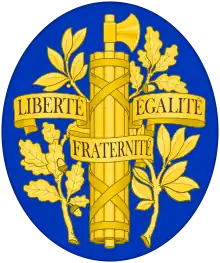1958 French legislative election
Legislative elections were held in France on 23 and 30 November 1958 to elect the first National Assembly of the French Fifth Republic.[1]
| |||||||||||||||||||||||||||||||||||||
All 576 seats in the National Assembly 290 seats needed for a majority | |||||||||||||||||||||||||||||||||||||
| |||||||||||||||||||||||||||||||||||||
 |
|---|
Since 1954, the French Fourth Republic had been mired in the Algerian War.[2] In May 1958, Pierre Pflimlin, a Christian-Democrat, became Prime Minister.[3] He was known to be in favour of a negotiated settlement with the Algerian nationalists.[4] On 13 May riots broke out in Algiers, with the complicity of the army.[5] A rebel government seized power in Algiers in order to defend "French Algeria". The next day, General Massu demanded the return to power of General Charles de Gaulle.[6]
The rebellious generals took control of Corsica threatening to conduct an assault on Paris, involving paratroopers and armoured forces based at Rambouillet.[6] In Paris, the political leaders were trying to find a compromise.[7] On 1 June De Gaulle replaced Pflimlin to lead a government of national unity and nominated as Ministers of State (Vice-Prime Ministers) Pierre Pflimlin (Popular Republican Movement, MRP), Guy Mollet (French Section of the Workers' International (SFIO), Louis Jacquinot (National Center of Independents and Peasants, CNIP) and Félix Houphouët-Boigny.[8] He obtained the right to develop a new Constitution.[9] Only the Communists and some center-left politicians such as Pierre Mendès-France and François Mitterrand, opposed this "coup against the Republic".[7][10]
On 28 September the new Constitution was approved in a referendum in the French Union by 82.6% of all voters, and in metropolitan France by 79.3% of voters. The Fifth Republic was born. The two-round system was re-established for the legislative elections.[11] The Gaullists created the Union for the New Republic which became the largest parliamentary group. Their opponents were crushed. The small number of left-wing MPs elected may be explained by divisions among left-leaning parties between supporters and opponents to the Fifth Republic: the two-round ballot tends to reward parties which are able to form alliances with each other.[12]
On 21 December de Gaulle was elected President of France by an electoral college.[13] His Justice Minister Michel Debré became Prime Minister.[14] The pro-Fifth Republic center-left parties (SFIO and Radical Party) left the presidential majority.[15][1] This established the first gaullist centre-right government.
Results (Metropolitan France)
| Party | First round | Second round | Total seats | |||
|---|---|---|---|---|---|---|
| Votes | % | Votes | % | |||
| National Centre of Independents and Peasants and Moderates | 4,092,600 | 19.97 | 4,250,083 | 23.60 | 132 | |
| French Communist Party | 3,882,204 | 18.94 | 3,741,384 | 20.78 | 10 | |
| Union for the New Republic and Gaullists | 3,603,958 | 17.58 | 4,769,052 | 26.48 | 189 | |
| French Section of the Workers International | 3,167,354 | 15.45 | 2,484,417 | 13.80 | 40 | |
| Radical Party, Dissidents and Republican Centre | 2,695,287 | 13.15 | 1,398,409 | 7.77 | 37 | |
| Popular Republican Movement and Christian Democrats | 2,387,788 | 11.65 | 1,365,064 | 7.58 | 57 | |
| Far-right | 669,518 | 3.27 | 1 | |||
| Total | 20,498,709 | 100.00 | 18,008,409 | 100.00 | 466 | |
| Source: Macridis & Brown[16] | ||||||
Notes
- Macridis & Brown 1960, pp. 253–266.
- Macridis & Brown 1960, pp. 26–44.
- Laponce 1961, pp. 1–2.
- Laponce 1961, pp. 9–10; Macridis & Brown 1960, pp. 60–61.
- Macridis & Brown 1960, p. 62.
- Watson 2003, pp. 123–129; Macridis & Brown 1960, pp. 81–91.
- Macridis & Brown 1960, pp. 92–97.
- Laponce 1961, pp. 12–13; Macridis & Brown 1960, p. 154.
- Macridis & Brown 1960, p. 117.
- Mitterrand 1964.
- Macridis & Brown 1960, pp. 210–236, 335–358.
- Macridis & Brown 1960, pp. 249–266.
- Macridis & Brown 1960, p. 182, 270.
- Macridis & Brown 1960, p. 152, 273.
- Macridis & Brown 1960, pp. 242–246.
- Macridis & Brown 1960, p. 258, N.B.: Unofficial and partly reconstructed
References
- Macridis, Roy C; Brown, Bernard Edward (1960). Long, Norton E. (ed.). The De Gaulle Republic: Quest For Unity. The Dorsey Series in Political Science (1st ed.). Homewood: The Dorsey Press. LCCN 60-14048. OCLC 408387. Retrieved 11 November 2014.
- Laponce, J. A. (1961). The government of the Fifth Republic: French Political Parties and the Constitution. Berkeley, Los Angeles; London: University of California; Cambridge University. LCCN 60-14656. OCLC 501634. Retrieved 11 November 2014 – via Internet Archive.
- Watson, William E. (2003). Tricolor and Crescent: France and the Islamic World. Perspectives on the twentieth century (10th ed.). Westport: Praeger. ISBN 0-275-97470-7. ISSN 1538-9626. LCCN 2002030336. OCLC 50322732. Retrieved 11 November 2014.
- Mitterrand, François (1964). Le Coup d'Etat permanent (in French). Paris: Plon.